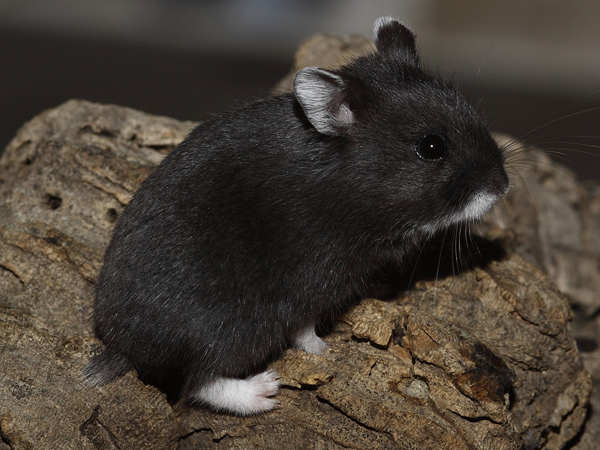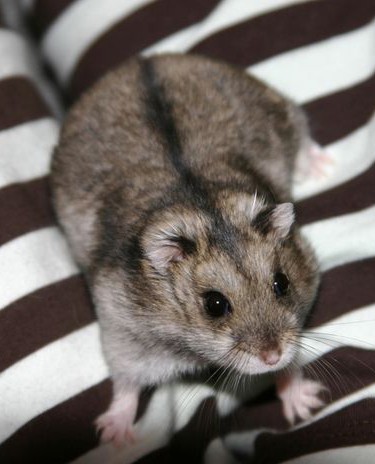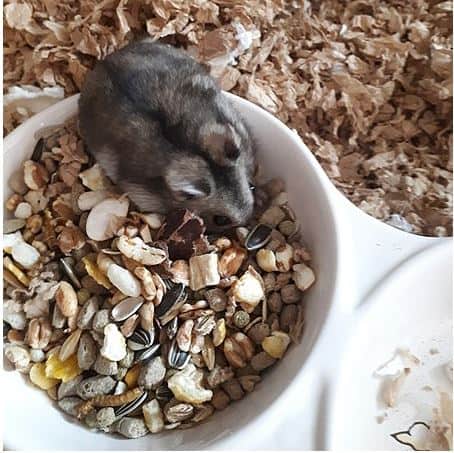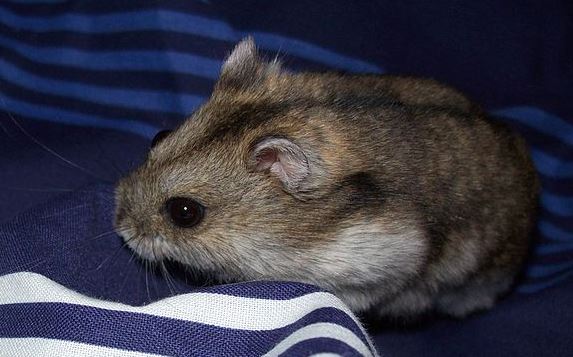Campbell’s dwarf hamster is a small rodent native to China, Kazakhstan, Mongolia, and Russia. They’re usually a gray brownish color with a dark dorsal stripe running along their spine.
Campbell’s hamsters make interesting pets. They’re not the most affectionate hamster breed but if they’re well socialized they don’t mind being handled. This, combined with their low-maintenance nature makes them popular pets.
However, while taking care of them is not rocket science, you do need to know the basics. Today, we’re going to take a closer look at this little hamster. We’ll discuss where they’re from, how to care for them, how much they cost, and much more. Let’s dig in!
Campbell’s Dwarf Hamster Fact Sheet
| Name | Campbell’s Dwarf Hamster |
| Size | 2 to 4 inches in length |
| Weight | 1 to 2 ounces |
| Experience level | Beginner-friendly |
| Lifespan | 2 to 3 years |
| Temperament | Friendly |
| Colors | Agouti, Albino, Argente, Black-eyed argente, Opal & Black |
| Coat length | Short |
| Can live with others? | Yes, but not always |
Origins of Campbell’s Dwarf hamster
As the name suggests, this breed was named after a man named Campbell. He collected the first hamster of this breed in Mongolia in 1902. These hamsters are very similar to the Winter White hamster, the main difference is that Campbell’s have smaller ears, no dark fur on their crown, and a narrower dorsal stripe. Interestingly enough, these two hamster breeds are so similar to one another that they can produce offspring together.
Appearance 🐹

On average, Campbell’s hamsters are about 2 to 4 inches long and weigh between 1 and 2 ounces. They’re characterized by their relatively small ears and narrow dorsal stripe.
They’re usually gray-brown in color with a darker dorsal stripe but can also have different colors. Here is a chart of all the basic colors that Campbell’s hamsters can have
| Color Name | Shade | Belly color | Undercoat | Ear Leather | Eyes | Dorsal stripe |
| Agouti | Gray-brown | White/off-white | Gray | Gray | Black | Black |
| Albino | White | White | White | Pink | Red | None |
| Argente | Cinnamon | Ivory | Dark brown | Pink | Red | Dark brown |
| Black-eyed Argente | Cream with brown tipping | Ivory | Dark brown | Pink | Black | Dark brown |
| Opal | Smokey grey, blue tipping | Off-white | Lighter gray | Dark gray | Black | Dark gray |
| Black | Solid black | Black | Black | Dark gray | Black | None |
In addition, they can also have various two-gene colors:
- Beige (combination of argente and black-eyed argente)
- Blue Fawn (combination of opal and argente)
- Lilac fawn (combination of opal and black-eyed argente)
- Blue (combination of opal and black)
- Dove (combination of argente and black)
- Chocolate (combination of black-eyed argent and black)
And even three-gene colors!
- Red-eyed Lilac (combination of opal, red-eyed argente, and black)
- Black-eyed Lilac (combination of opal, black, and black-eyed argente)
- Blue Beige (combination of opal, red-eyed argente, and black-eyed argente)
- Dark beige (combination of red-eye argente, black-eyed argente, and black)
And if that wasn’t enough, they can even have two different coat types:
- Satin (smooth and soft)
- Rex (curly)
As you can see, Campbell’s dwarf hamsters come in quite a diverse range of colors. This is excellent for pet owners because it offers a wide range of options when buying one.
Temperament

Campbell’s dwarf hamsters are not the most affectionate breed. That honor goes to the Syrian. Nevertheless, they’re usually quite friendly and respond well to being handled as long as they’ve been adequately socialized.
They’re typically not aggressive and do not frequently bite. Do be careful though, they are small animals and because of that, they get scared quite easily. If they’re scared they bite out of self-defense instinct. They’re also very quick and nimble, which can make handling them quite challenging at times. Make sure that you handle them close to the ground to prevent dropping them on accident.
As opposed to some other breeds, it’s possible for Campbell’s dwarf hamsters to share their cage with another hamster or a small group of the same breed. When doing so, it’s best to introduce them to one another at a young age. This allows them to start forming a bond and often helps to prevent territorial behavior and fights. Nevertheless, aggression is sometimes unavoidable and if this occurs make sure to separate them.
Caring for a Campbell dwarf hamster

Caring for these animals is quite straightforward due to their simple diet, low grooming requirements, and easy housing. Nevertheless, you do have to know what you’re doing, so follow this short guide to learn everything you need to know to adequately care for your furry friend.
Diet 🥬
Like other breeds, Campbell’s hamsters are omnivores. This means that they can eat a wide range of foods. They’re typically not picky eaters and will eat almost anything. However, just because they can eat something does not always mean that they should.
The ideal diet for your Campbell hamster consists of 80 to 90% pellets with the remaining 10 to 20% consisting of fresh fruits and veggies. You can give them a piece of meat, fish, or nuts as a treat occasionally.
Some hamster owners choose to feed them a seed mix rather than pellets but this is not ideal. While hamsters are not particularly picky eaters they do have their preferences when it comes to food. Because of this, they’ll often eat only their favorite seeds and then wait until you refill their food bowl. This can lead to nutritional imbalances. This does not happen with commercial pellets because these pellets have been created to contain everything your furry friend needs in every bite. When buying pellets, it’s ideal to buy those that have between 12 and 24% protein.
Some foods that these hamsters like to eat include:
- Vegetables: Carrots, asparagus, squash, broccoli, romaine lettuce
- Fruits: Apples (no seeds), bananas, pears, grapes, blueberries
- Others: Salmon, turkey, chicken
Before feeding something to your hamster, always make sure that they can safely eat it. Some foods, such as onion and garlic are safe for humans, but not safe for hamsters.
Grooming ✂️
Campbell’s hamsters are very particular about keeping themselves clean. If you keep an eye on them you’ll notice that they spend many hours a day cleaning themselves, often even after you’ve touched them.
Because they’re so keen on being clean you don’t have to worry about grooming them. They do not need baths or haircuts or anything of the sort. The best thing you can do to help them in their grooming endeavors is to provide them with a sand bath and a fresh, clean cage.
Housing 🏡
A single Campbell’s hamster needs a cage that’s a minimum of 24 inches long and 12 inches wide with at least 450 square inches of floor space. Keep in mind that this is a minimum for them to be comfortable, if you can afford and have the space for a bigger cage, always do so. They love big cages!
If you house more Campbell’s in the same cage, make sure that you increase their cage size adequately to offer enough space for all of them. This helps to prevent aggression and territorial behavior.
Wire-cages with plastic bottoms that can be bought from pet shops or online are a good choice. They allow good ventilation and also allow your hamster to climb the bars of the cage if they want to. However, in order for them to safely climb the cage, you do have to pay attention to bar spacing. Bar spacing (the amount of space between the bars of the cage) should be around ¼ inches.
Some people also choose to house their hamsters in glass tanks. This is a possibility, but The Purdue College of Veterinary Medicine recommends a wire cage over a tank because of better ventilation and easier cleaning.
Essential cage components
To help your Campbell feel at home in its new home it will need some furnishing. You’re free to decorate their cage how you want, but there are a few things that every hamster needs in their cage. These things are:
- An exercise wheel. Hamsters are little balls of energy. They need a way to release that energy and an exercise wheel is a great way for them to do so.
- Hiding houses or huts. Everyone needs some privacy now and then, including your hamster.
- Food bowl and water bottle. These speak for themselves, they need a place to eat and drink from!
- Chew toys. Hamsters are rodents and as such their teeth never stop growing. Provide them with wooden chew toys to allow them to keep their teeth in check.
Of course, you’ll also need bedding. Aspen shavings or commercial bedding like Kaytee are good choices. Avoid bedding that’s made of pine or cedar because it can irritate your hamster’s airways.
Lifespan & health of Campbell’s hamsters
Campbell’s hamsters are generally a healthy breed. They’re not more prone to any disease than other breeds. However, there are some common issues that all dwarf hamster breeds face. These include:
- Wet tail. All hamsters can suffer from wet tail. Wet tail is caused by a bacterial infection and results in diarrhea. Make sure that you take them to a vet immediately if you think they have this because it can be lethal.
- Diabetes. Dwarf hamsters are more prone to diabetes than other breeds. Make sure that you do not feed them too many sugary snacks such as sweet fruits.
- Overgrown teeth. Because hamsters are rodents their teeth never stop growing. To combat this, they grind them down. However, if they do not have access to material to grind down their teeth they can become overgrown. This can be painful and prevent proper eating. Always make sure that they have access to plenty of chew toys!
On average, Campbell hamsters have a lifespan of about 2 to 3 years.
Taming Campbell’s dwarf hamsters

Luckily enough, Campbell’s Dwarf Hamsters are not hard to tame. If you follow these 5 steps, you’ll have him eating out of your hand in no time!
- Let the hamster get used to its new environment.
- Spend time near your hamster to let it get used to you, your scent, and your presence.
- Put your hand in their cage to let them get used to your scent. You can also offer them a treat.
- Once they’re eating the treats out of your hand, you can start touching them. If they respond well, move on to step 5.
- You can now gently try picking your hamster up and holding it. Do this carefully, they’re very agile creatures so make sure that you do not drop them!
When taming your hamster it’s important that you do this at the right time. Campbell’s are nocturnal animals. This means that they’re active during the evening/night and sleep during the day. Make sure that you do perform the taming process in the evening for the best results.
Buying Campbell’s hamsters
Campbell’s hamsters are not rare. They’re available at almost any pet shop and there are many breeders that sell them.
When buying a hamster, it’s recommended to purchase from a breeder rather than a pet shop. Pet shops often get their hamsters from rodent mills where they’re treated very poorly. These hamsters are not ethically bred and raised which can result in poor socialization and health.
Buying from a breeder is a little more expensive but you’re much more likely to get a healthy, sociable hamster.
On average, the price of a Campbell hamster from a reputable breeder is around $20 to $25.
Final words
Campbell’s dwarf hamsters are good pets for people who want an animal that’s easy to tame and fun to play with. They might not form the bonds with their owners that cats and dogs do, but they’re still very fun companions.
Their friendly nature, willingness to be handled, and easiness to tame make them great pets for beginners as well as experienced pet owners. On top of that, the fact that they’re low-maintenance makes them easy to take care of.
If you’re looking for a cute, small pet to spice up your house the Campbell hamster could be a great fit for you.
If you’d like to discover other breeds, perhaps these are of interest:
- How Long Do American Eskimo Dogs Live? Important Factors and Care Tips - September 29, 2023
- Do American Bulldogs Need Grooming? Essential Tips and Care Guidelines - September 29, 2023
- Do Bengal Cats Enjoy Playing? Essential Tips for Keeping Them Active - September 29, 2023